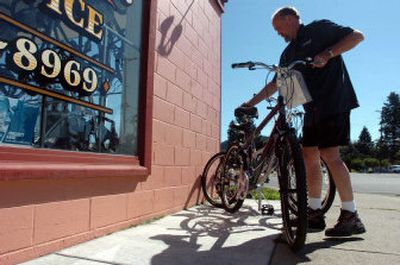Full cycle

Steve Shultz rode alongside Lance Armstrong, about one month before the Tour de France, at a bicycle ride in Austin, Texas. Commenting to Armstrong that he was 33 years old when he retired from the competitive international racing scene, Armstrong turned his head, smiled and replied, “That’s a great age to retire.”
Armstrong, the winner of the 2005 Tour de France, has retired after his seventh Tour victory at age 33 – an average retirement age for biking competitors, according to Shultz.
Besides retirement ages, Shultz has something else in common with Armstrong – his passion for the sport of cycling.
Shultz, the owner of Bicycle Sales and Service, opened his Coeur d’Alene store in 1995. He grew up in San Diego, and at age 13 saw a group of cyclists in colorful jerseys on lightweight racing bikes.
“Right then I said to myself I have to do that someday,” Shultz says.
He joined a bicycle club, starting cycling at 14, and starting racing at 15. By the age of 17 he was winning races.
“It was my life. It totally consumed me,” Shultz says.
It was typical for him to show up at high school with cleated cycling shoes on his feet after having ridden 40 miles before school began.
Shultz became a member of the San Diego Bicycle Club and was fortunate enough to have members of the U.S. Olympic Cycling Team take him under their wing.
Shultz raced actively up to his early 20s, took a break, and moved to Berkeley, Calif., where he continued to race while he worked at Velo Sport Cyclery.
Velo was known nationwide as “the premier bicycle shop,” had a staff of more than 40 people, and enough inventory to fill 13,000 square feet. Shultz became general manager in 1974 at the age of 30.
“We consistently sold 60 to 70 bicycles a day,” Shultz says. “Cycling was my life.”
Shultz eventually moved to Issaquah, Wash., where he became a sales rep for Nishiki, which was a popular brand in the 1970s and 1980s.
Shultz’s opportunity to meet and ride with Armstrong came as a result of his affiliation with the Trek Bicycle Corp. of Waterloo, Wis. Trek flew 70 of their best dealers nationwide to Austin to participate in a bicycle ride with Armstrong as part of a benefit for the Lance Armstrong Foundation.
At the top of his game, Armstrong was diagnosed with advanced testicular cancer that had spread to his lungs and his brain. Doctors gave him little hope for survival. He recovered from cancer, though, and came back stronger than ever.
Since his first win, he has leveraged his athletic success and popularity to raise money for cancer research. He established the Lance Armstrong Foundation, a nonprofit organization that provides practical information and tools people need to battle cancer and “Live Strong” through education, advocacy, public health programs, and research grants. More than 55 million of Armstrong’s popular “Live Strong” yellow wrist bands have been sold to support cancer research.
Shultz met Armstrong briefly twice before at trade shows and at Trek sales meetings. He generally found him to be a bit stiff and impatient, but this experience during the Austin ride was different.
Shultz was impressed with Armstrong’s sense of humor and his quickness.
On this trip Shultz realized that Armstrong loved bicycles as much as he did.
“Lance Armstrong is a very complicated person, but he loves the bicycle because it is so simplistic,” Shultz said. “This bicycle ride changed my mind about Armstrong – he was on his bike this time – he was at home on the bicycle.”
The Lance Armstrong Foundation hosted a dinner/auction after the ride which, Shultz says, featured Sheryl Crow singing “Are You Strong Enough to be My Man?” directly to Armstrong.
“The crowd loved it,” Shultz said.
Shultz and his son, John, a Seattle microbiologist, had another opportunity to see Armstrong in action when they traveled to France as part of a Trek travel group on July 10. Each day they were part of a group that was able to ride the bicycle route either before or after the actual Tour de France competitors.
“Watching it on television does not come close to the excitement of hearing 500,000 to 1 million people per day cheer on the Tour competitors,” Shultz said. “The roar of the crowd, the music, the festival atmosphere with helicopters flying overhead – being there is a thrilling experience.”
Shultz says most people have tremendous respect for Armstrong even though the media has reported that the French people have spat on him, yelled insults and have thrown beer in his face.
“The negativity of the crowd made Armstrong’s will to win even stronger,” Shultz says.
According to Shultz, actor Robin Williams, a close friend, and Crow, his girlfriend, were there every day to support Armstrong during the Tour de France.
“It was always a dream of mine when I was young to race in the Tour, but I was 37 years old before the first American ever rode in the Tour de France,” Shultz says. “There was not a single American cyclist who could qualify for that level of competition in those years.”
As Shultz reminisces about the “trip of a lifetime,” he is quick to comment, “No one, in my opinion, has done more for the sport of cycling in the world than Lance Armstrong.”